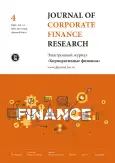Dynamic Mapping of Probability of Default and Credit Ratings of Russian Banks
- Authors: Khromova E.
- Issue: Vol 14, No 4 (2020)
- Pages: 31-46
- Section: New Research
- URL: https://journal-vniispk.ru/2073-0438/article/view/303157
- DOI: https://doi.org/10.17323/j.jcfr.2073-0438.14.4.2020.31-46
- ID: 303157
Cite item
Full Text
Abstract
Investors are interested in a quantitative measure of banks’ credit risk. This paper maps the credit ratings of Russian banks to default probabilities for different time horizons by constructing an empirical dynamic calibration scale. As such, we construct a dynamic scale of credit risk calibration to the probability of default (PD).
Our study is based on a random sample of 395 Russian banks (86 of which defaulted) for the period of 2007-2017. The scale proposed by this paper has three features which distinguish it from existing scales: dynamic nature (quarterly probability of default estimates), compatibility with all rating agencies (base scale credit ratings), and a focus on Russian banks.
Our results indicate that banks with high ratings are more stable just after the rating assignment, while a speculative bank’s probability of default decreases over time. Hence, we conclude that investors should account for not only the current rating grade of a bank, but also how long ago it was assigned. As a result, a rising capital strategy was formulated: the better a bank’s credit rating, the shorter the investment horizon should be and the closer the date of investment should be to the rating assignment date in order to minimise credit risk.
The scientific novelty of this paper arises from the process of calibration of a rating grade to dynamic PD in order to evaluate the optimal time horizon of investments into a bank in each rating class. In practical terms, investors may use this scale not only to obtain a desired credit rating, but also to identify quantitative measure of credit risk, which will help to plan investment strategies and to calculate expected losses.
Keywords
References
- Volk M. Estimating Probability of Default and Comparing It to Credit Rating Classification by Banks. Economic and Business Review. 2013;14(4):523.
- Shi B., Chi G., Li W. Exploring the mismatch between credit ratings and loss-given-default: A credit risk approach. Economic Modelling. 2020;85:420-428. doi: 10.1016/j.econmod.2019.11.032
- Shi B., Zhao X., Wu B., Dong Y. Credit rating and microfinance lending decisions based on loss given default (LGD). Finance Research Letters. 2019;30:124-129. doi: 10.1016/j.frl.2019.03.033
- Tasche D. The art of probability-of-default curve calibration. Journal of Credit Risk. 2013;9(4):63-103. doi: 10.21314/JCR.2013.169
- Pomasanov M., Vlasov A. Calibration of national rating systems. Rynok cennykh bumag = Security Market. 2008;12(363):74-79. (In Russ.)
- Pomasanov M., Hamalinsky A. Rating Model Calibration for Sectors with a Low Number of Defaults. Financial Risk Management. 2012;02(30):82-94.
- Rudakova O., Ipatyev K. Some Approaches to the Calibration of Internal Rating Models. Review of European Studies. 2015;7(10):25-36. doi: 10.5539/res.v7n10p25
- Godlewski C. Are Ratings Consistent with Default Probabilities?: Empirical Evidence on Banks in Emerging Market Economies. Emerging Markets Finance and Trade. 2007;43(4):5-23. doi: 10.2753/REE1540-496X430401
- Chan-Lau J. Fundamentals-Based Estimation of Default Probabilities: A Survey. IMF Working Papers. 2006;06(149). doi: 10.5089/9781451864090.001
- Schuermann T., Hanson S. Estimating Probabilities of Default. Federal Reserve Bank of New York Staff Reports. 2004;190.
- Karminsky A.M., Khromova E. Increase of banks' credit risks forecasting power by the usage of the set of alternative models. Russian Journal of Economics. 2018;4(2):155-174. doi: 10.3897/j.ruje.4.27737
- Zhivaikina A.D., Peresetsky A.A. Credit ratings of Russian banks and reviews of banking licenses 2012–2016 yy. Journal of the New Economic Association. 2017;4(36):49-80. (In Russ.)
- Vernikov A., Bobkov V. Quality of governance and bank valuation in Russia: an empirical study. Journal of Corporate Finance. 2008;3(7):5-16.
- Karminsky A.M., Sosurko V.V. The unified rating mapping: a step from the myth to reality. Bankovskoe delo = Banking Subject. 2011;6:58-63. (In Russ.)
- Hainsworth R., Karminsky A.M., Solodkov V.M. Arm's length method for comparing rating scales. Eurasian Economic Review. 2013;3(2):114-135. doi: 10.14208/eer.2013.03.02.002
- Dyachkova N. The comparison of rating scales of Russian and foreign agencies for industrial and financial companies. Journal of Corporate Finance Research. 2018;12(2):35-52. (In Russ.)
- Demeshev B.B., Tikhonova A.S. Dynamics of Predictive Power of Insolvency Models for Russian Small-medium Enterprises: Wholesale and Retail Trade. Journal of Corporate Finance Research. 2014;8(3):4-22. doi: 10.17323/j.jcfr.2073-0438.8.3.2014.4-22 (In Russ.)
- Morgunov A.V. Modeling the Probability of Default of the Investment Projects. Journal of Corporate Finance Research. 2016;10(1):23-45. doi: 10.17323/j.jcfr.2073-0438.10.1.2016.23-45 (In Russ.)
- Totmyanina K.M. Assessment the probability of default for corporate borrowers given macroeconomic situation. Journal of Corporate Finance Research. 2014;8(1):19-31. doi: 10.17323/j.jcfr.2073-0438.8.1.2014.19-31 (In Russ.)
- Rybalka A.I. Modeling Probability of Default in the Construction Sector: Factors of Corporate Governance. Journal of Corporate Finance Research. 2017;11(3):79-99. doi: 10.17323/j.jcfr.2073-0438.11.3.2017.79-99 (In Russ.)
- Zakharova A.A., Telipenko E.V. Selection of risk factors of bankruptcy of an enterprise based on the method of main components. Journal of Corporate Finance Research. 2014;8(1):64-72. doi: 10.17323/j.jcfr.2073-0438.8.1.2014.64-72 (In Russ.)
Supplementary files










